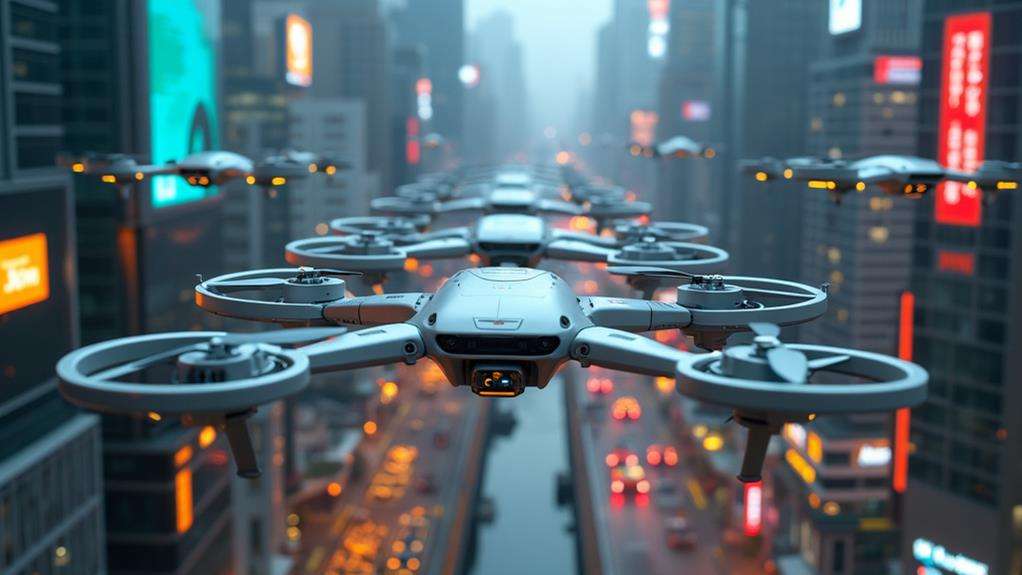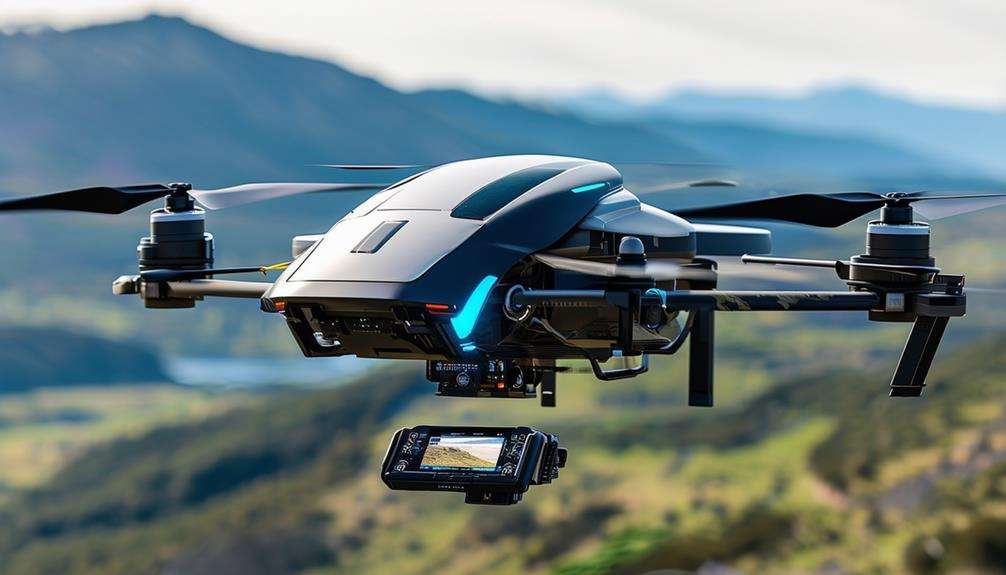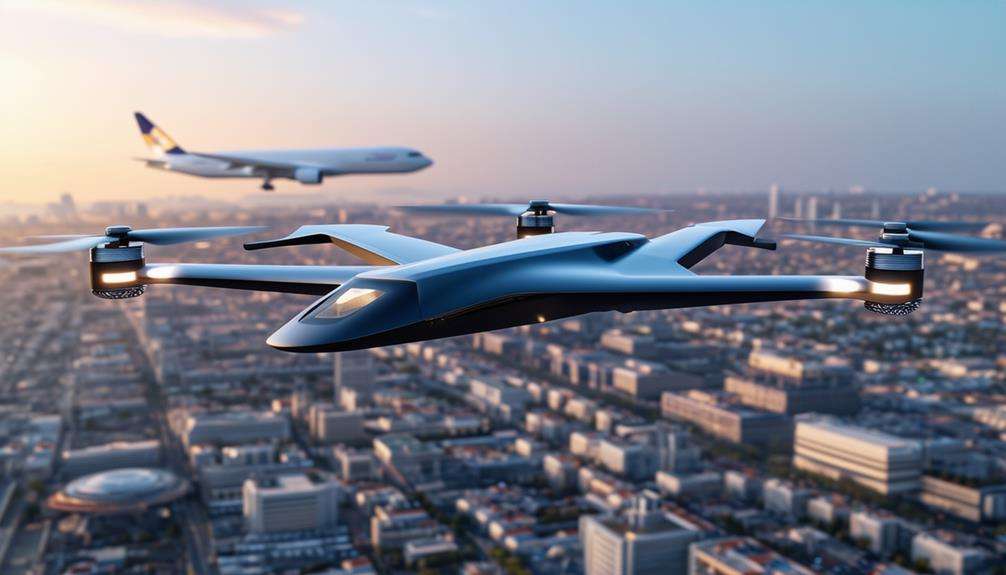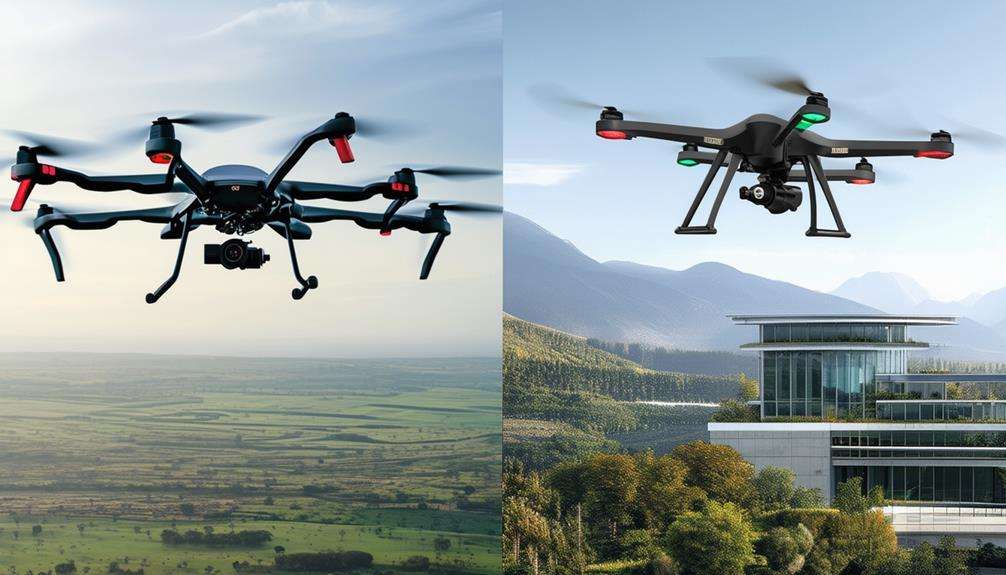The First Drones: Pioneers in UAV Technology
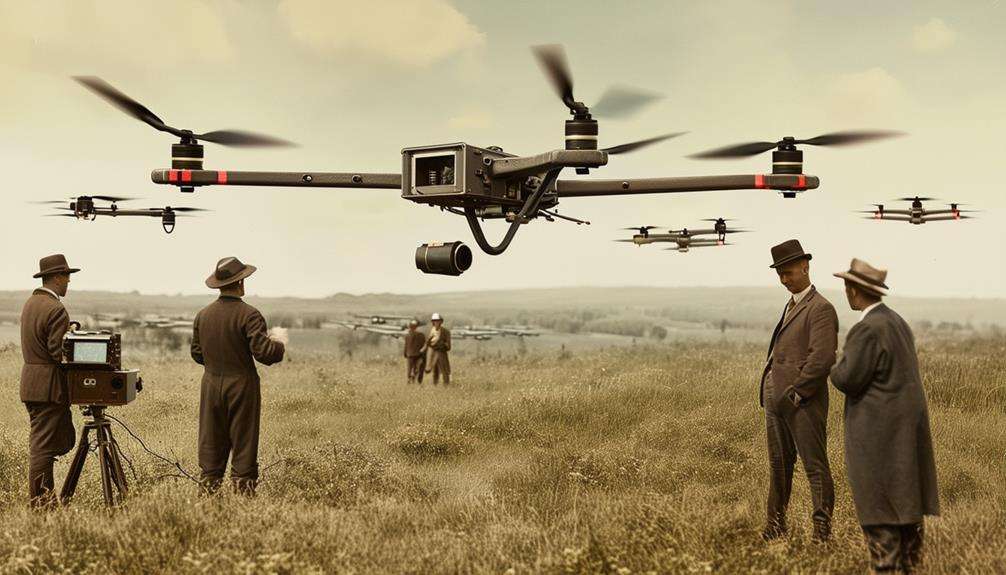
When you think of drones, you might picture sleek, modern devices, but their origins trace back much further. The story begins with Austrian incendiary balloons in 1849, marking the first military use of unmanned aerial vehicles (UAVs). These early UAV concepts evolved significantly over the decades, with innovations during World War I, such as the British Hewitt-Sperry Automatic Airplane and the U.S. Army's Kettering Bug. These pioneering efforts laid the foundation for modern UAV technology. Understanding how each subsequent period built on these early innovations reveals the journey to the advanced, multifaceted drones we see today.
Early UAV Concepts
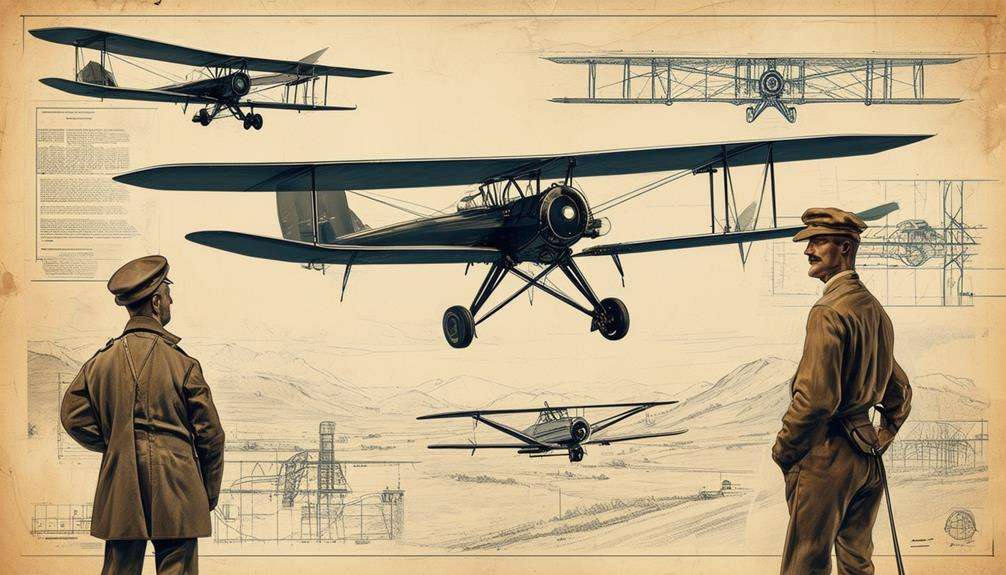
In the early days of UAV development, the concept of unmanned flight began with creative ideas like the Austrian incendiary balloons used in 1849. These early experiments in Venice marked the initial recorded use of an unmanned aerial vehicle (UAV) for military purposes. Although primitive, these incendiary balloons set the stage for future innovations in unmanned flight.
The progression from these balloons to more sophisticated UAVs was driven by imaginative and pioneering efforts. The evolution of unmanned aircraft wasn't just about removing the human element from flight; it was about leveraging technology to accomplish objectives that were too dangerous or complex for manned missions.
The idea of an unmanned aircraft didn't stop with balloons. By the early 20th century, the understanding and development of UAVs had advanced significantly. Innovations during this period laid the groundwork for the sophisticated drones we've today.
These early concepts demonstrated the potential of UAVs, showing that even without a pilot, aerial vehicles could perform critical tasks, pushing the boundaries of what was possible in aviation.
World War I Innovations
World War I marked the inception of pilotless aircraft, a pivotal advancement in UAV technology. British forces spearheaded significant innovations in 1917 and 1918, notably with the Hewitt-Sperry Automatic Airplane introduced in September 1917. This breakthrough demonstrated the potential of remotely controlled flight, paving the way for future developments.
The British continued their efforts with the DH.82B Queen Bee, which was crucial in refining UAV technology. This remotely controlled aircraft showcased early success in unmanned aviation.
Meanwhile, in 1918, the United States Army developed the Kettering Bug, an early cruise missile. Although it was too late to see combat, the Kettering Bug was a significant milestone, capable of carrying explosives over long distances without a pilot.
These World War I innovations laid the groundwork for future UAV development, proving the practicality and effectiveness of remotely controlled aircraft. Early efforts by British forces and the US Army initiated a technological revolution in aerial warfare.
Interwar Period Developments
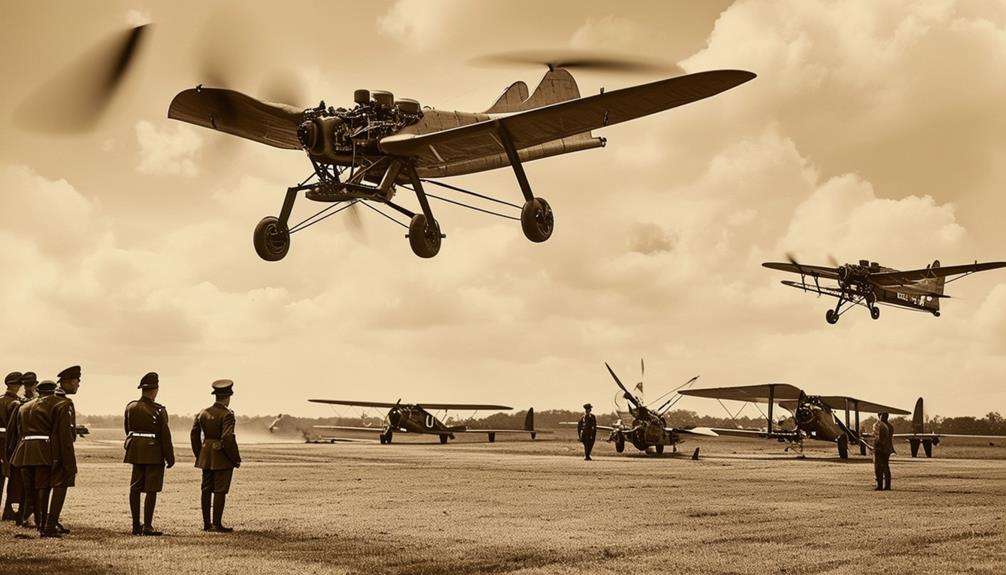
During the interwar period, early prototypes of UAVs and other military innovations began to take shape. Notable advancements included the Royal Navy's Larynx cruise missile and the Fairey Queen radio-controlled drone. Additionally, Hungarian scientist Dénes Mihály's work on television guidance systems played a pivotal role in this era of experimentation.
Early UAV Prototypes
Pioneering efforts in the interwar period led to the conversion of Standard E-1s into some of the earliest drones, marking a significant leap in UAV experimentation. The Royal Flying Corps played a pivotal role, transforming these aircraft into remotely piloted vehicles (RPVs). One standout development was the De Havilland Queen Bee, a radio-controlled target drone. This innovation demonstrated the potential of pilotless aircraft for military training purposes.
The Royal Navy also tested the Larynx cruise missile, another remarkable step in UAV technology. Meanwhile, Hungarian scientist Dénes Mihály Tihanyi investigated television guidance systems for drones, foreshadowing the modern remote piloting techniques we use today. The Fairey Queen, developed in 1931, served as another radio-controlled target drone, showcasing the rapid advancements in this field.
Here's a snapshot of these groundbreaking efforts:
| Year | Innovation | Developer | Significance |
|---|---|---|---|
| Post-WWI | Standard E-1 Conversion | Royal Flying Corps | Early RPV Experimentation |
| 1930s | De Havilland Queen Bee | Royal Navy | Radio-Controlled Target |
| 1931 | Fairey Queen | Royal Navy | Advanced UAV Target |
| 1927-1928 | Larynx Missile | Royal Navy | Early Cruise Missile Test |
| 1930s | Television Guidance | Dénes Tihanyi | Early Remote Piloting Research |
These early prototypes laid the groundwork for future UAV advancements, proving their value and versatility.
Military Innovations Emerge
During the interwar period, significant advancements in UAV technology emerged, building on early prototypes. The Royal Navy's testing of the Larynx cruise missile marked a notable milestone, showcasing early unmanned aerial technology. This era was characterized by groundbreaking experimentation and innovation, setting the stage for modern UAVs.
Hungarian scientist Tihanyi made notable contributions by exploring television guidance for drones, hinting at the potential for more sophisticated control systems in military UAVs. The conversion of Standard E-1 aircraft into drones post-World War I marked a clear shift toward embracing unmanned aerial vehicles for various military applications.
In 1931, the development of the Fairey Queen radio-controlled target demonstrated practical applications of UAV technology within military contexts. This innovation showed that drones could serve as effective training tools, improving the accuracy and preparation of military personnel.
Throughout the interwar period, these experiments and innovations significantly advanced drone technology. The strides made during these years were critical, paving the way for the sophisticated unmanned aerial vehicles that would follow in subsequent decades.
World War II Advances
During World War II, early UAV prototypes revolutionized military reconnaissance missions. The US Navy, along with innovators like Reginald Denny, pushed technological boundaries with models such as the OQ-2 and RP-1. These advancements laid the foundation for the modern drones in use today.
Early UAV Prototypes
World War II marked significant advancements in UAV technology, with prototypes like the Radioplane OQ-2 and Curtiss N2C-2 laying the groundwork for modern drones. Key figures in this development included Reginald Denny, a Hollywood actor and aviation enthusiast, who created the RP-1 and later produced the Radioplane OQ-2 for military use.
The OQ-2 drone, launched at Wright Field in October 1945, was a pivotal moment in UAV history, demonstrating the potential of radio-controlled aircraft for military applications. Edward M. Sorensen also made substantial contributions by patenting radio-controlled aircraft technology, which underpinned the development of the OQ-2 and other early UAV prototypes.
The OQ-2 wasn't just a technological milestone; it embodied the escalating interest and investment in UAV technology during the war. The US Navy's experimentation with the Curtiss N2C-2 drone in 1937 further underscored the military's commitment to exploring unmanned aerial vehicles for various applications. Collectively, these advancements during World War II set the stage for the sophisticated drones we see today, highlighting the crucial role of early innovators in UAV technology.
Military Reconnaissance Missions
The US Navy's successful deployment of the OQ-2 drone for reconnaissance missions during World War II marked a groundbreaking advancement in UAV technology. As one of the first operational drones, the OQ-2 set the stage for future military applications, demonstrating the significant advantage of gathering intelligence without risking human lives. The introduction of the Radioplane OQ-3 in October 1945 at Wright Field underscored the rapid evolution of reconnaissance drones in the post-World War II era.
During the Vietnam War, the US military further leveraged UAV technology by deploying Ryan Firebee drones for surveillance missions. The US Air Force flew over 3,400 reconnaissance drones over North Vietnam, highlighting the critical role of UAVs in providing real-time intelligence that profoundly influenced military strategies and operations.
The use of drones continued to evolve, as seen during the Iran-Iraq War, where the Qods Mohajer-1 drone was developed, showcasing the versatility of UAVs in both reconnaissance and combat missions. This progression from World War II through the Vietnam War and beyond illustrates the essential and expanding role of UAVs in modern military reconnaissance.
Technological Innovations Emerged
Pioneering advances in drone technology emerged with the US Navy's deployment of the OQ-2 drone in October 1945, demonstrating the potential of unmanned aerial vehicles (UAVs) in military operations. These innovations during World War II paved the way for future developments in both military and civilian applications.
Several key milestones trace the evolution of UAV technology:
- Curtiss N2C-2 Drone (1937): The US Navy's early experiments with radio-controlled UAVs, like the Curtiss N2C-2, marked the beginning of practical drone applications in military settings.
- Radioplane OQ-2: Produced by Reginald Denny's Radioplane Company, the OQ-2 drone was primarily used for target practice, underscoring the growing significance and viability of UAVs.
- Military Target Practice: Utilizing drones like the OQ-2 for training purposes reduced risks to human pilots during practice missions.
- Foundation for Modern UAVs: World War II-era advancements in drone technology laid the groundwork for the evolution of modern UAVs, including those used in reconnaissance and combat missions.
These technological innovations during World War II not only showcased the potential of drones but also fundamentally transformed military strategies, setting the stage for the advanced UAVs utilized today.
Reginald Denny's Contributions
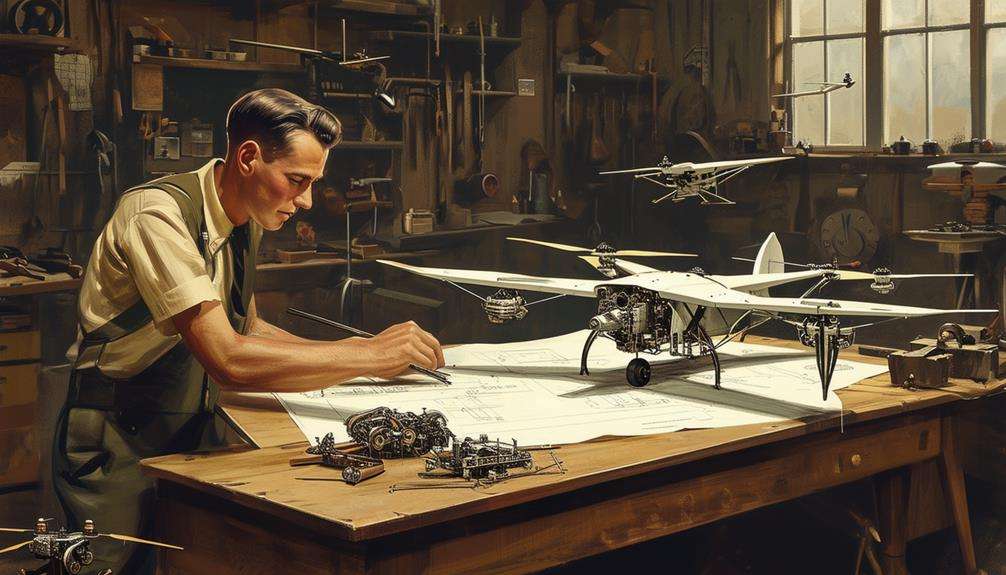
Reginald Denny revolutionized UAV technology by developing the Radioplane RP-1 drone, which he presented to the US Army in 1935. His work laid the groundwork for modern drones by integrating radio-controlled aircraft technology. The RP-1 represented a significant breakthrough, but it was during World War II that Denny's contributions had their greatest impact.
During the war, Radioplane produced the OQ-2 drone, a major advancement in military training. This drone provided a reliable and cost-effective way for soldiers to practice their targeting skills, allowing the military to train effectively without risking human pilots. This marked a pivotal moment in drone technology, demonstrating the practical applications of Denny's vision.
Edward M. Sorensen's patent on radio-controlled aircraft technology also played a vital role. His work enabled Denny to perfect the remote operation of his drones, enhancing their versatility and efficiency. Together, their innovations propelled UAV technology forward. Denny's pioneering work with Radioplane was instrumental in shaping the future of military drones, setting a foundation that continues to influence UAV development to this day.
Cold War UAV Evolution
During the Cold War, UAV technology experienced rapid advancements driven by the demand for superior military capabilities and strategic advantages. This period witnessed significant progress in the design and deployment of drones, which played crucial roles in various military operations.
One important development was the introduction of purpose-built target drones like the BTT series, which revolutionized training for anti-aircraft gunners. The Globe company made notable contributions with innovations such as target drones and decoy drones, exemplified by the Northrop Crossbow. These drones were essential for confusing enemy defenses and enhancing military effectiveness.
Another milestone was the conversion of the RP-71 drone for aerial photo reconnaissance, allowing for the collection of critical intelligence data without risking human lives. The ADM-20 Quail, a decoy drone used to simulate bomber aircraft, further enhanced strategic deception capabilities.
Key developments in Cold War UAV technology include:
- Target Drones: The BTT series, used for training anti-aircraft gunners.
- Decoy Drones: The Northrop Crossbow, designed to mislead enemy defenses.
- Aerial Photo Reconnaissance: The RP-71 drone conversion for intelligence gathering.
- ADM-20 Quail: A decoy drone used to simulate bomber aircraft for strategic deception.
These innovations collectively pushed the boundaries of UAV technology, laying the groundwork for future advancements in unmanned aerial operations.
Surveillance and Reconnaissance
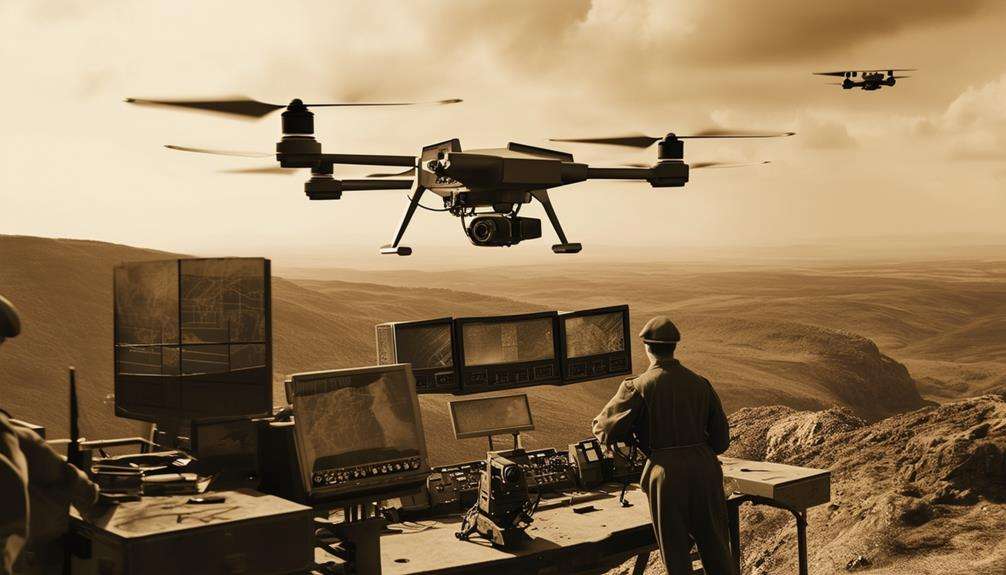
The use of drones for surveillance and reconnaissance has significantly transformed military operations, providing unparalleled intelligence and battlefield awareness. These unmanned aerial vehicles (UAVs) have evolved from early balloon reconnaissance to the sophisticated drones utilized today. By delivering real-time data and continuous surveillance, drones have become essential in modern warfare.
The British Army's use of the Midge Surveillance Drone during the Gulf War exemplifies how drones have revolutionized reconnaissance. These drones, equipped with pre-programmed flight paths and rocket-powered propulsion, were crucial for artillery spotting and intelligence gathering.
Here is a brief overview of the impact of drones on surveillance and reconnaissance over time:
| Time Period | UAV Model | Key Feature |
|---|---|---|
| Mid-19th Century | Balloons | Early aerial reconnaissance |
| Cold War | Early Recon Drones | Initial advancements in UAV technology |
| Gulf War | Midge Surveillance Drone | Rocket-powered, pre-programmed flight paths |
| Modern Day | Various UAVs | Real-time data provision |
| Present | Advanced Recon Drones | Persistent surveillance capabilities |
Drones have provided unparalleled intelligence, enabling military forces to make informed decisions swiftly. From the mid-19th century to today, UAVs have consistently advanced the capabilities of reconnaissance and surveillance. The continuous evolution of these vehicles continues to shape military strategies and operations globally.
Miniature UAVs Emergence
In the late 20th century, the emergence of miniature UAVs transformed numerous fields by providing compact, agile, and versatile aerial platforms. Their lightweight design and ease of operation made them ideal for tasks that larger drones couldn't perform. The Israeli Air Force significantly contributed to this development by integrating these small but powerful remotely piloted vehicles (RPVs) into their operations.
Miniature UAVs have become indispensable in several key areas:
- Surveillance and Reconnaissance: They deliver real-time intelligence crucial for modern warfare and security operations.
- Urban Monitoring: Their size and maneuverability allow them to navigate confined spaces, making them ideal for urban environments.
- Scientific Research: Scientists use them to gather data in hard-to-reach places, enhancing our understanding of various ecosystems.
- Disaster Response: They provide rapid assessments of affected areas, aiding in efficient disaster management.
The history of unmanned aerial vehicles (UAVs) witnessed a significant advancement as early drone prototypes evolved into sophisticated miniature UAVs. Their roles in modern warfare and civilian applications underscore the remarkable progress in UAV technology. Continuous innovation ensures that these small drones keep expanding the boundaries of what's possible.
Modern UAV Applications
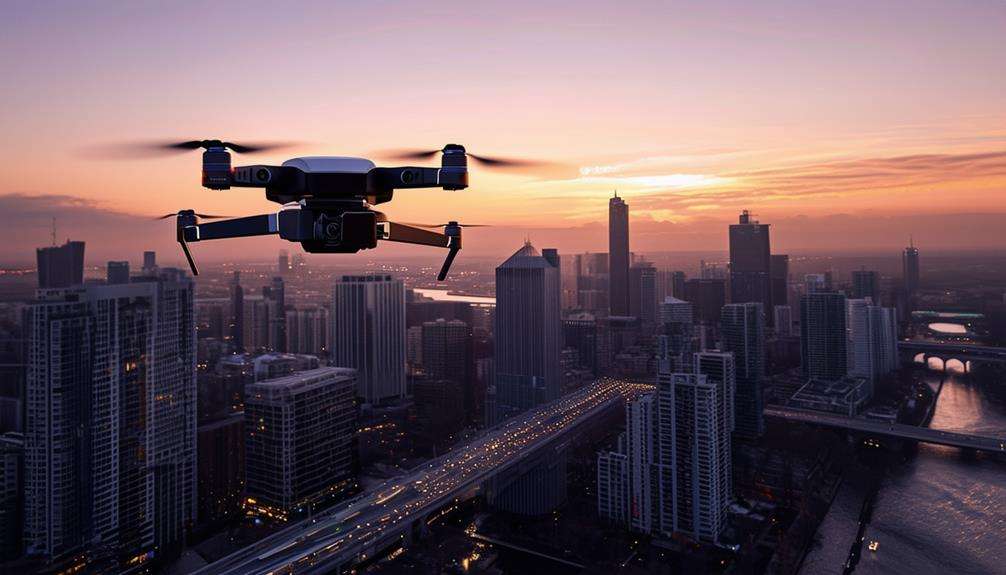
Modern UAV applications span a wide array of fields, significantly impacting military operations, border security, and civilian sectors. In the United States, the Army Air Forces have extensively integrated drones into their operations. Reconnaissance drones are essential for intelligence gathering, while combat drones execute offensive missions such as targeted killings and airstrikes. These drones, remotely operated, provide real-time data, enhancing decision-making capabilities.
Target drones are crucial for training military personnel by simulating enemy aircraft and missile threats, allowing the Army Air Forces to prepare for various combat scenarios effectively. The advent of vertical takeoff and landing (VTOL) drones has further broadened operational flexibility, enabling missions in diverse terrains and conditions.
Nevertheless, the use of drones isn't without controversy. Issues such as accountability, transparency, potential hacking, constant surveillance, civilian casualties, and arms control provoke significant debate. Despite these challenges, drones remain indispensable in modern warfare and border security, particularly in counterterrorism operations.
Conclusion
UAV technology has evolved significantly, from simple Austrian incendiary balloons to today's sophisticated drones. Each period, from World War I to the present, has seen critical innovations that have shaped modern UAVs.
As advancements continue, we can expect groundbreaking applications in surveillance, reconnaissance, and beyond. The pioneering efforts of the past have laid the foundation for an exciting future in unmanned aerial technology.

